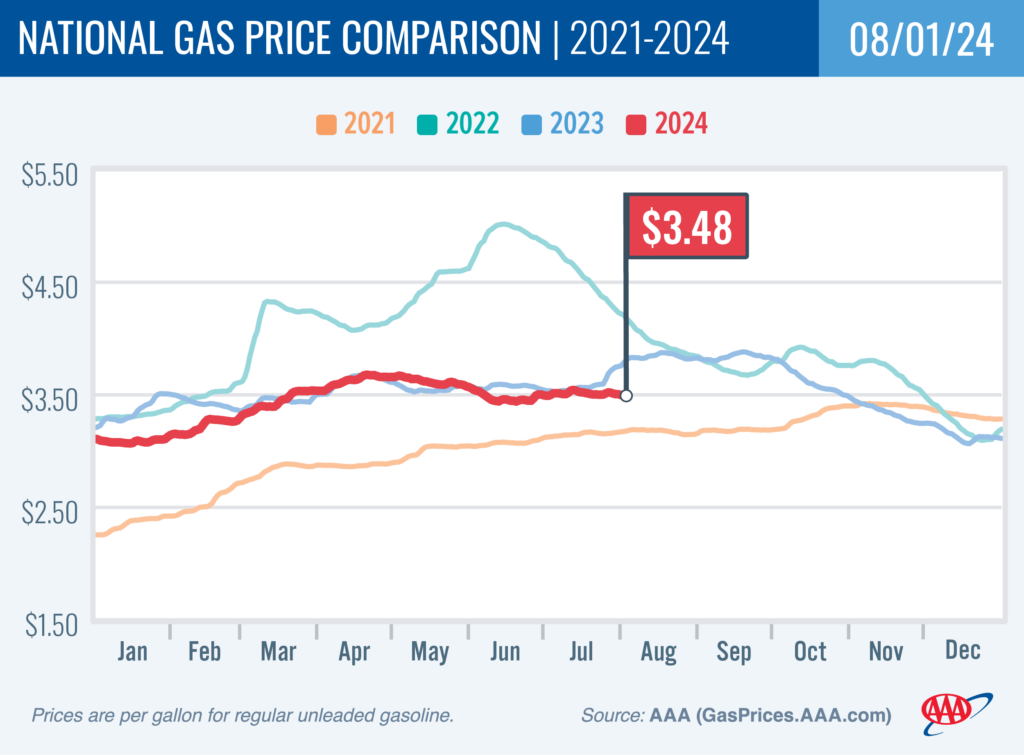WASHINGTON, D.C. (August 1, 2024)—The national average for a gallon of gas dipped four cents since last week to $3.48. The drop comes as a tropical wave with storm-forming potential is slowly approaching the Caribbean Sea. Should it enter the Gulf of Mexico, expect oil prices to move higher.
“The oil market is volatile, and the threat of a hurricane impacting production and refining will certainly grab its attention,” said Andrew Gross, AAA spokesperson. “Add in the rising tensions in the Middle East, and oil prices are poised to push higher.”
Meanwhile, AAA is rolling out a new feature today, with much more to come. With an estimated 1.2 million AAA members living in a household with one or more electric vehicles, AAA is adding the kilowatt-per-hour cost for Level 2 (L2) commercial charging by state – more details below. AAA members are 28% more likely than the US adult population overall to have an electric vehicle.
Today’s national average for a kilowatt of electricity at an L2 commercial charging station is 34 cents.
According to new data from the Energy Information Administration (EIA), gas demand slid from 9.45 million b/d to 9.25 last week. Meanwhile, total domestic gasoline stocks fell from 227.4 to 223.8 million barrels. Gasoline production decreased last week, averaging 10.0 million barrels per day. Lower gasoline demand but higher oil costs may lead to flat or slowly rising pump prices dipping, but this depends on Atlantic storm development.
Today’s national average for a gallon of gas is $3.48, a penny less than a month ago and 30 cents less than a year ago.
Oil Market Dynamics
At the close of Wednesday’s formal trading session, WTI rose dramatically by $3.18 cents to settle at $77.91 a barrel. The EIA reports that crude oil inventories decreased by 3.4 million barrels from the previous week. At 433.0 million barrels, U.S. crude oil inventories are about 4% below the five-year average for this time of year.

Quick Gas and Electricity Stats
Gas
Since last Thursday, these 10 states have seen the largest weekly changes in their gasoline averages: Indiana (-13 cents), Michigan (-11 cents), Ohio (-10 cents), South Carolina (-9 cents), Colorado (+7 cents), Wisconsin (-6 cents), Idaho (+6 cents), Kentucky (-6 cents), South Dakota (+6 cents), and Illinois (-6 cents).
The nation’s top 10 least expensive gasoline markets are Mississippi ($2.96), Louisiana ($3.05), Arkansas ($3.08), Texas ($3.09), Alabama ($3.10), Oklahoma ($3.10), Tennessee ($3.11), South Carolina ($3.12), Kansas ($3.18), and Missouri ($3.19).
Electric
The nation’s top 10 least expensive states for L2 commercial charging per kilowatt hour are Kansas (22 cents), Missouri (24 cents), Delaware (25 cents), Texas (28 cents), Nebraska (29 cents), Utah (29 cents), Wisconsin (29 cents,) Vermont (30 cents), Michigan (30 cents) and Washington, DC (30 cents).
The nation’s top 10 most expensive states for L2 commercial charging per kilowatt hour are Hawaii (56 cents), West Virginia (45 cents), Idaho (42 cents), South Dakota (42 cents), Arkansas (42 cents), Kentucky (42 cents), Montana (41 cents), Tennessee (42 cents), New Hampshire (41 cents) and Alaska (40 cents).
Drivers can find current gas and electric charging prices along their route using the AAA TripTik Travel planner.
###
